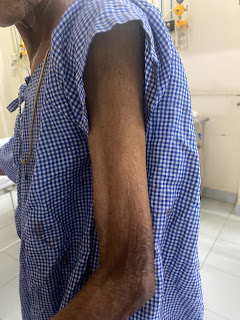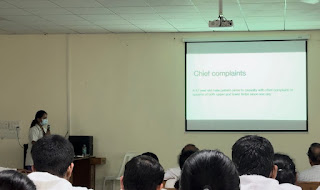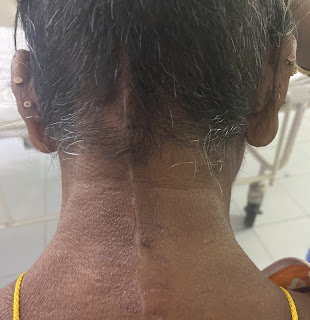MY EXPERIENCES WITH GENERAL CELLULAR AND NEURAL CELLULAR PATHOLOGY IN A CASE BASED BLENDED LEARNING ECOSYSTEM'S CBBLE
MY EXPERIENCES WITH GENERAL CELLULAR AND NEURAL CELLULAR PATHOLOGY IN A CASE BASED BLENDED LEARNING ECOSYSTEM'S CBBLE
The journey of becoming a medical professional begins with a unique experience—the first interaction between a medical student and patient .This initial encounter holds immense significance as it sets the foundation for our understanding of patient care, empathy, and the ethical responsibilities associated with the medical profession.
My first patient interaction was in 3rd semester.it was first day of my general medicine postings..I was posted in OP ,a patient of28 years old female came with complaints of fever associated with chills and rigors, my PG asked me to check BP , that was my first time checking BP to a patient.
I felt surreal that I started interacting with patients.I was there taking her history completely and our PG asked about differential diagnosis. I checked her temperature.we thought it may be dengue so we sent for investigations.I was with my patient taking her to investigations.on that day I got to learn how to ask history and ask leading questions which takes us to diagnosis.
First case -
This patient was 32 years old , I saw him in AMC .I went to him to ask about his complaints but he was soo weak and his was barely speaking, he told me that he is having high fever with chills so I approached his wife to take his history.after taking history I examined his respiratory system..
on examination I found there was decreased vocal fremitus on right lower side and on percussion there was dullness note heard in mammary,axillary,infraaxillary areas.on auscultation normal vesicular breath sounds not heard in mammary area.
After seeing X-ray we found that it was pleural effusion (blunting of costophrenic angle)
Pleural tap was done.but even after giving analgesics and antibiotics there was no decrease in fever.
Pleural tap fluid was sent to investigations there we found increase in lymphocytes .so we suspected it may be TB, and we sent for ADA levels..and there was increased. Then we we sent sputum sample for CBNAAT which was positive.
While dealing with this patient I got to learn how to correlate our clinical examination with the investigations.i ve learned about pleural effusion and TB.
This is the case i came across during my clinical rounds
During my postings I saw this old patient with his wife she came to me asking about his husband condition then i approached him and asked about his complaints he responded that he could not remember things. I was bit aback to take a CNS case as i was not sure and good at examination is this part but I took it as a challenge and I started taking his history patient was very good at telling his problem I did examinations on patient and I got confidence this was the first time I got to do lobar function tests and MMSE
During the encounter, I performed thorough neurological examination. This typically includes evaluating cranial nerves, motor and sensory function, reflexes, coordination, and gait. As i proceeded through the examination, you may find yourself recalling anatomy and physiology lessons, recalling the intricate details of the nervous system and its functions.
Higher mental functions
MMSE score - 16
Conscious, oriented to person , place and time .
Speech : normal
Memory: loss of recent memory
No Visual hallucinations
No delusions
No emotional lability.
CRANIAL NERVE EXAMINATION:
1st : Normal
2nd : visual acuity is normal
3rd,4th,6th : normal
5th : sensory intact
motor intact
7th : normal
8th : No abnormality noted.
9th,10th : palatal movements present and equal.
11 th : intact
12 th : normal
Motar examination
Cns R. L
Tone UL N N
LL hyper. Hyper
Power UL 4/5. 4/5
LL 4/5. 4/5
Reflexes
B -. -
T. - -
S. -. -
K. -. -
A. -. -
P. Extensor flexor
Lobar function tests
Frontal
- He know about hospitalization
- did not give history properly
- No able memorize numbers orderly
- able to say phalam , Samayam , cinema
- Able to 10 names of vegetables, animals in one minute
- Motor luria test - done
- proverbs - able to say
- Luria graphic test - able to draw triangle and square
Orbital and basal
Go and no go test
1. Direction - 2 errors
2. color -able to say
Parietal lobe
Ideational apraxia - able to perform folding of paper as shown .
Right left orientation- present
Temporal lobe
Recent memory - absent
Remote Memory - present but not able to recall some events
Immediate memory present
Delusion and hallucinations - absent
Occipital lobe
Prosopagnosia - present
Visual memory
SENSORY EXAMINATION:
SPINOTHALAMIC SENSATION:
R L
Crude touch : Normal Normal
pain : Normal Normal
temperature : Normal Normal
DORSAL COLUMN SENSATION:
R L
Fine touch : normal Normal
Vibration sense : normal Normal
Proprioception : normal Normal
CORTICAL SENSATION:
R L
Two point discrimination : normal Normal
Tactile localisation : normal Normal
CEREBELLAR EXAMINATION:
Slight tremors are present
Nystagmus -absent



Comments
Post a Comment